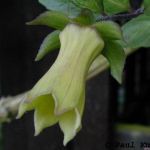| Common Name: |
Dang Shen |
| Other Names: |
Bastard ginseng, bellflower |
| Botanical Name: |
Codonopsis pilosula |
| Genus: |
Codonopsis |
| Family: |
Campanulaceae |
| Location: |
NE Asia |
| Cultivation: |
Light, well-drained, sandy, slightly acid soil in semi-shade. |
| Propagation: |
By seed sown under cover in spring or autumn; by cuttings of basal shoots in spring. Seedlings have delicate taproots, needing care when transplanting. |
| Harvest: |
Roots are lifted in autumn from plants at least three years old and used fresh, or dried for decoctions by threading onto strings and rubbing vigorously at intervals to distribute moisture until completely dry. Often used in the form of a tincture by Western herbalists. |
| Height: |
2m (6ft) |
| Hardiness: |
Z5-9 |
| Parts Used: |
Roots (dang shen) |
| Properties: |
A sweet, warm, soothing herb, taken as an energy tonic. It acts mainly on the spleen, lungs, and stomach, raising body-fluid secretions and blood sugar levels, lowering blood pressure, and stimulating the immune system. |
| Medicinal Uses: |
Internally for low energy, poor appetite and digestion, anemia, shallow breathing, asthma, fatigue, and debility after illness. In Chinese folk medicine to stimulate milk production in nursing mothers. Often cooked with rice until glutinous as a tonic food. |
| Culinary Uses: |
Roots are roasted with millet or eaten raw, baked, or pickled in miso. An ingredient of tonic teas and soups in China. |
| Bibliography: |
Encylopedia of Herbs by Deni Brown Copyright ©: 1995, 2001 Dorling Kindersley Limited pg 174
|

